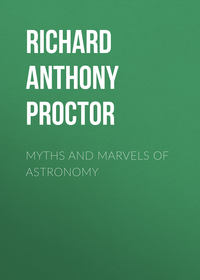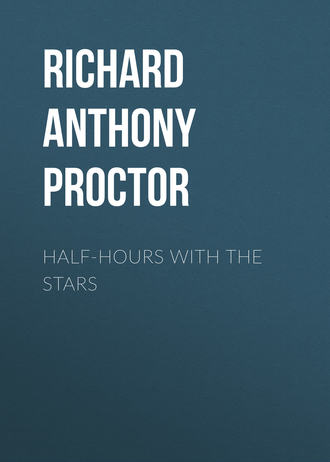 полная версия
полная версияHalf-Hours with the Stars
The southwestern sky is very barren of bright stars. Alfard, the heart of the Sea Serpent, Hydra, shines here alone in a great blank space. Above the Sea Serpent's head we see the Sickle in the Lion, Leo himself stretching his tail to due south, very high up. Coma Berenices is close by, and the Hunting Dogs (Canes Venatici) between Coma and the Great Bear.
In the south, lower down, we find the Crow (Corvus), and the Cup (Crater), on the Serpent's back; the Virgin (Virgo), extending in the mid-heavens from southeast to south, between the Lion's tail and the Crow. In the same direction, but low down, we find the head and body of the Centaur (Centaurus), supposed to have typified the patriarchal Noah.
In the southeast the Scorpion's heart has just risen, and between the head of Scorpio and the Virgin's robes we see the stars of the Scales (Libra).
Due east, low down, is the Serpent-Holder (Ophiuchus), on his back—it is the customary attitude of heavenly bodies when rising. The Serpent (Serpens) held by him is seen curving upward toward the Crown (Corona Borealis). The Serpent's head is due west, and above it we see the bright Arcturus, chief brilliant of the Herdsman (Boötes).
In the northeast is Hercules, his head close to the head of the Serpent-Holder. Beneath his feet is the Lyre (Lyra) with the brilliant Vega; and the Swan (Cygnus) has already half risen above the northeastern horizon.
Lastly, the Dragon (Draco) curves from between the Pointers and the Pole, round the Guardians toward Cepheus, and then retorts its head, with gleaming eyes (β and γ), toward the heel of Hercules.
NIGHT SKY.—MAY AND JUNE
The Great Bear (Ursa Major) occupies all the upper sky from the west to north, except a small space occupied by the Hunting Dogs (Canes Venatici). The Pointers are in the northwest, almost horizontal. A line from the Pole Star (α of the Little Bear—Ursa Minor) to the Guardians of the Pole (β and γ) now occupies the position of the minute hand of a clock 3 minutes past an hour.
Due north, low down, lies Cassiopeia, while above, somewhat toward the east, we find the inconspicuous constellation Cepheus. The Camelopard is in the west of north, and getting upright.
Low down in the northwest lie the Charioteer (Auriga), and the head stars of the Twins (Gemini) further west. The Crab (Cancer) is nearly due west, the Sea Serpent (Hydra) holding his head almost exactly to the west point. Above is the Sickle in the Lion, its blade curved downward, and the tail of the Lion (Leo) lies above, toward the south of west.
On the Serpent's back we find the Cup (Crater) and the Crow (Corvus), in the southwest and to the south of southwest respectively. Above these constellations, and extending beyond the south toward the east, the Virgin (Virgo) occupies the mid-heavens.
Above the Virgin we see the Herdsman (Boötes), his head and shoulders nearly overhead. Low down in the south is the Centaur (Centaurus), bearing on his spear the Wolf (Lupus) as an offering for the Altar (Ara), which, however, is invisible in these latitudes. Above the Wolf we see the Scales (Libra), while the Scorpion (Scorpio), one of the few constellations which can at once be recognized by its shape, is rising balefully in the southeast.
The Serpent Bearer (Ophiuchus) bears the Serpent (Serpens) in the mid-heavens toward the southeast, the Crown (Corona Borealis) being high up in the east, close by the Serpent's head.
Low down in the east is the Eagle (Aquila), with the fine steel-blue star Altair, the Swan on the left about northeast, and above it the Lyre (Lyra), with the still more brilliant steel-blue star Vega. Hercules occupies the space between the Lyre on the one side and the Crown and the Serpent's head on the other. He is high up, due east.
Lastly, the Dragon winds from between the Pointers and the Pole round the Little Bear, toward Cepheus, and then eastward toward the feet of Hercules, close by which we see his head and gleaming eyes (β and γ).
MAP VI. NIGHT SKY.—MAY AND JUNE.
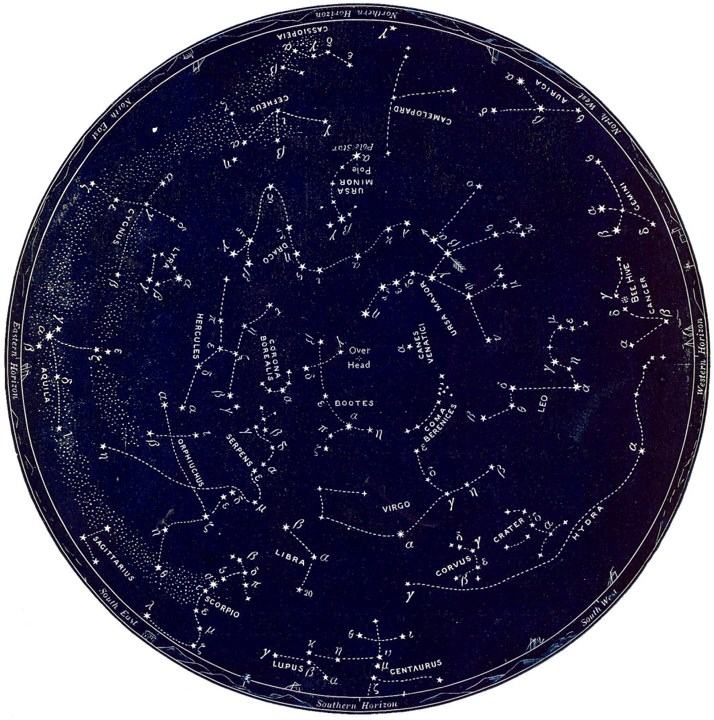

Stars of the first magnitude are eight-pointed; second magnitude, six-pointed; third magnitude, five-pointed; fourth magnitude (a few), four-pointed; fifth magnitude (very few), three-pointed. For star names refer to page 4.
MAP VII. NIGHT SKY.—JUNE AND JULY.


Stars of the first magnitude are eight-pointed; second magnitude, six-pointed; third magnitude, five-pointed; fourth magnitude (a few), four-pointed; fifth magnitude (very few), three-pointed. For star names refer to page 4.
NIGHT SKY.—JUNE AND JULY
The Great Bear (Ursa Major) is in the mid-heavens toward the northwest, the Pointers not far from the horizontal position. They direct us to the Pole Star (α of the Little Bear, Ursa Minor). The line from this star to the Guardians of the Pole, β and γ, is in about the position of the minute hand of a clock 2 minutes before an hour. The Dragon (Draco) curls over the Little Bear, curving upward on the east, to where its head, high up in the northeast, is marked by the gleaming eyes, β and γ. Under the Little Bear, the Camelopard has at last come upright.
Low down in the west the Lion (Leo) is setting. The point of the "Sickle in the Lion" is turned toward the horizon; the handle (marked by α and η) is nearly horizontal. Above the Lion's tail is Berenice's Hair (Coma Berenices); and between that and the Great Bear's tail our chart shows a solitary star of the Hunting Dogs (Canes Venatici). The Crow (Corvus) is low down in the southwest, the Cup (Crater) beside it, partly set, on the right. Above is Virgo, the Virgin. Still higher in the southwest—in fact, with head close to the point overhead—is the Herdsman (Boötes), the Crown (Corona Borealis) near his southern shoulder marking what was once the Herdsman's uplifted arm.
Low down between the south and southwest we find the head and shoulders of the Centaur (Centaurus), who holds the Wolf (Lupus) due south. Above the Wolf are the Scales (Libra), and above these the Serpent (Serpens), his head in the south, stretching toward the Crown. In the mid-sky, toward the southeast, we find the Serpent Bearer (Ophiuchus—one star of the Serpent lies east of him). Below the Serpent Bearer we find the Scorpion (Scorpio), now fully risen, and showing truly scorpionic form. Beside the Scorpion is the Archer (Sagittarius), low down in the southeast. To his left we see, low down, two stars marking the head of the Sea Goat (Capricornus), and one belonging to the Water Bearer (Aquarius). Above the Sea Goat flies the Eagle (Aquila), with the bright star Altair; and above, near the point overhead, is the kneeling Hercules. Due east, we see part of the Winged Horse (Pegasus); above that, the little Dolphin (Delphinus), and higher, the Swan (Cygnus) and the Lyre (Lyra), with the beautiful bluish-white star Vega.
Lastly, low down, between north and northeast, we find the Seated Lady (Cassiopeia); and above, somewhat eastwardly, the inconspicuous constellation Cepheus, Cassiopeia's royal husband.
NIGHT SKY.—JULY AND AUGUST
The Great Bear (Ursa Major) is now in the northwest, his paws near the horizon. The Pointers (α and β) direct us to the Pole Star, (α of the Little Bear, Ursa Minor). A line from the Pole Star to the Guardians of the Pole is in the position of the minute hand of a clock about 7 minutes before an hour. Below the Little Bear we see the Camelopard, a little to the east of due north. The Dragon (Draco) curves round from between the Pointers and the Pole, above the Little Bear toward the east, then upward to near the point overhead, its head, with the bright stars β and γ, being highest. Low down in the west we see Berenice's Hair (Coma Berenices), and one star of the Hunting Dogs (Canes Venatici) is seen in the chart between Coma and the Great Bear. The Herdsman {Boötes) occupies the mid-heaven in the west, the Crown (Corona Borealis) higher up, and due west, Hercules, between the Crown and the point overhead.
Low down, extending from the west to near the southwest, we find the Virgin (Virgo), the bright Spica near its setting place. In the southwest are the Scales (Libra), and farther to the left, extending from the Scales to low down near the south, we find the Scorpion (Scorpio), one of the finest of the constellations, Antares, the rival of Mars (as the name means), marking its heart. Above the Scorpion and the Scales are the Serpent Bearer (Serpentarius or Ophiuchus) and the Serpent (Serpens), extending right across him to near the Crown, after which the Serpent seems reaching.
A little east due south, low down, we find the Archer (Sagittarius); in the southeast, low down, the Sea Goat (Capricornus); and farther east, and lower down, the Water Bearer (Aquarius). Above the Sea Goat is the Eagle (Aquila), with the bright bluish-white star Altair; on its left the pretty little Dolphin (Delphinus), and above the Dolphin, nearly overhead, the Lyre (Lyra), with the bluish-white star Vega (even brighter than Altair) nearly overhead.
Below the Lyre we see the Swan (Cygnus), due east; and below the Swan the Winged Horse (Pegasus), upside down, as usual.
In the northeast, Andromeda, the Chained Lady, is rising, her head marked by the star α (which was also called δ of Pegasus). (The "Square of Pegasus" is formed by α of Andromeda and α, β, and γ of Pegasus.)
Between the north and northeast is Cassiopeia, the Seated Lady, and above her, her husband, King Cepheus. And lastly Perseus is just rising, between the north and northeast.
MAP VIII. NIGHT SKY.—JULY AND AUGUST.
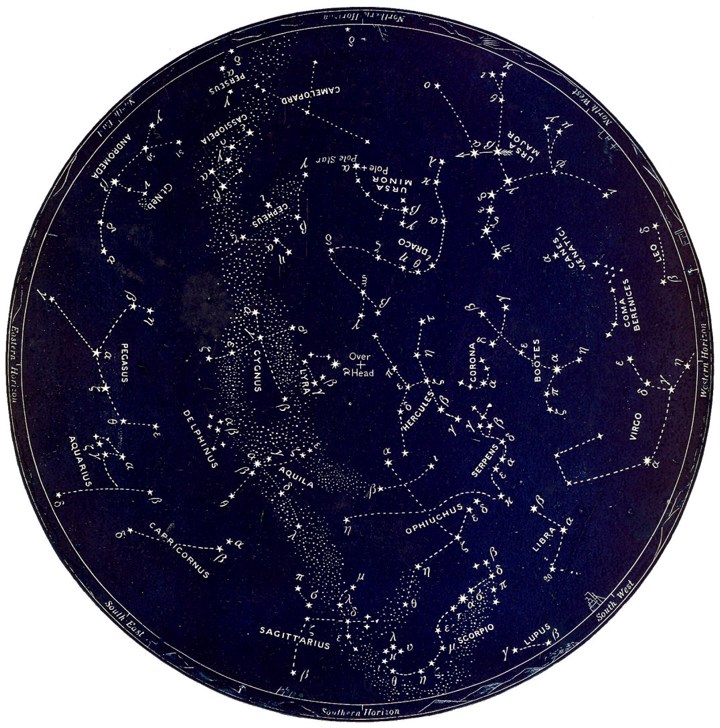

Stars of the first magnitude are eight-pointed; second magnitude, six-pointed; third magnitude, five-pointed; fourth magnitude (a few), four-pointed; fifth magnitude (very few), three-pointed. For star names refer to page 4.
MAP IX. NIGHT SKY.—AUGUST AND SEPTEMBER.
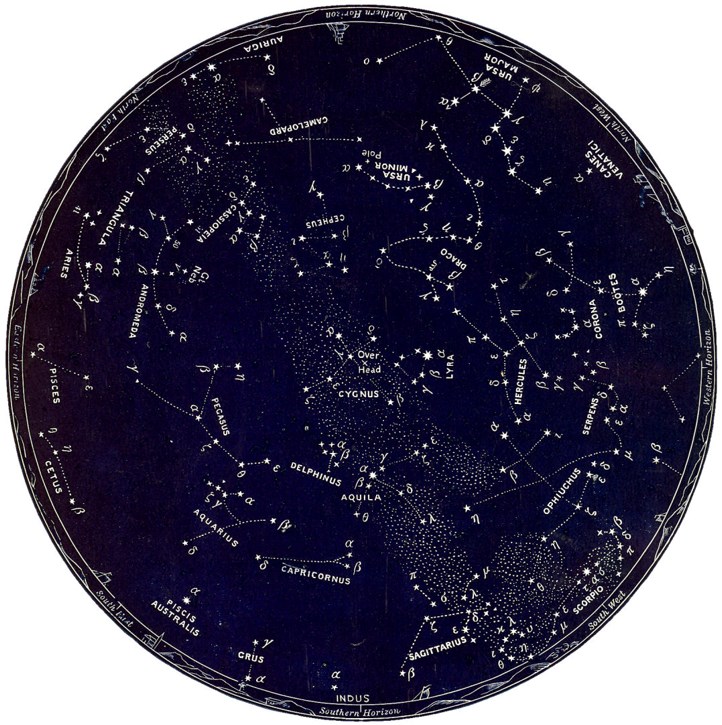

Stars of the first magnitude are eight-pointed; second magnitude, six-pointed; third magnitude, five-pointed; fourth magnitude (a few), four-pointed; fifth magnitude (very few), three-pointed. For star names refer to page 4.
NIGHT SKY.—AUGUST AND SEPTEMBER
The Great Bear (Ursa Major) is low down, between northwest and north, the Pointers (α and β) directed slantingly upward toward the Pole. A line from the Pole Star (α of the Little Bear, Ursa Minor) to the Guardians of the Pole (β and γ), is in the position of the minute hand of a clock 12 minutes before an hour. Between the Great Bear and the Little Bear run the stars of the Dragon (Draco), round the Little Bear toward the north, thence toward the northwest, where we see the head of the Dragon high up, its two bright eyes, β and γ, directed toward Hercules, which occupies the western mid-heaven. Above Hercules is Lyra, the Lyre, with the bright steel-blue star Vega high up toward the point overhead. Right overhead is the Swan (Cygnus).
Low down in the northwest we see in the chart one star of the Hunting Dogs (Canes Venatici). Nearer the west stands the Herdsman, rather slanting forward, however, with the Crown (Corona Borealis) on his left, almost due west. The long winding Serpent (Serpens) runs from near the Crown (where we see its head due west) to farther south than southwest, high up on the western side of the Serpent Holder (Serpentarius or Ophiuchus), now standing upright in the southwest. Low down creeps the Scorpion (Scorpio), its heart Antares, rival of Mars, in the southwest, the end of its tail between south and southwest. Above and south of the Scorpion's tail we see the Archer (Sagittarius).
Due south, and high up, is the Eagle (Aquila), its tail at ζ and ε, its head at θ, the bright steel-blue Altair marking its body. On the left, or east, of the Eagle lies the neat little Dolphin (Delphinus). Midway between the Dolphin and the horizon is the tip of the tail of the Sea Goat (Capricornus), whose head lies nearly due south.
On the southern horizon is the head of the Indian (Indus); on its left a part of the Crane (Grus), and low down in the southeast lies Fomalhaut, the chief brilliant of the Southern Fish (Piscis Australis). Above lies the Water Bearer (Aquarius), in the southwestern mid-heaven.
Due east, fairly high, is "the Square of Pegasus," the head of the Winged Horse, Pegasus lying close by the Water Pitcher of Aquarius (marked by the stars ζ, γ, and α).
The Fishes (Pisces) are low down in the east. A few stars of the Whale (Cetus) are seen on their right, very low down. On the left of Pisces we see the Ram (Aries), low down; above it the Triangle; and above that the Chained Lady (Andromeda).
Low down in the northeast is the Rescuing Knight (Perseus); above whom is Cassiopeia, and on her left, higher up, the inconspicuous constellation Cepheus.
Lastly, immediately below Cepheus, we find the Camelopard, below which, very low down, between north and northeast, is the Charioteer (Auriga), the brilliant Capella being just above the horizon.
NIGHT SKY.—SEPTEMBER AND OCTOBER
Low down, between north and northwest, we find the seven stars of the Dipper, the Pointers on the right nearly due north. They direct us to the Pole Star. The Guardians of the Pole (β and γ of the Little Bear, Ursa Minor) lie in a direction from the Pole Star corresponding to that of the minute hand of a clock about 17 minutes before an hour. Between the Pointers and the Pole Star we find the tip of the Dragon's tail: then passing round the Little Bear with the Dragon's long train of third magnitude stars, we come, after a bend, to the Dragon's head, with the two bright eyes, α and β—(part of the Dragon's nose has been borrowed by Hercules). These two stars are almost exactly midway between the horizon and the point overhead, and nearly northwest. King Cepheus—not a very conspicuous constellation—lies between the point overhead and the Little Bear.
Low down in the northwest we find the head of the Herdsman (Boötes). The Crown (Corona Borealis), which no one can mistake, lies on his left; and close by is the setting head of the Serpent. Above these three groups we see Hercules—the Kneeler—his head at α, his upraised club by γ. Above the head of Hercules we find the Lyre, with the bright star Vega; and above that the Swan.
Passing southward, we see the Serpent-Holder (Serpentarius or Ophiuchus), beyond whom lies the Serpent's tail; a most inconvenient arrangement, as the Serpent is divided into two parts. Almost exactly southeast, and low down, are the stars of the Archer (Sagittarius); while above, in the mid-sky, we see the Eagle (Aquila), with the bright Altair. Note the neat little constellation the Dolphin (Delphinus), close by.
Due south is the Crane (Grus); above it the Southern Fish, with the bright star Fomalhaut. Above that the Sea Goat (Capricornus), and on the left of this the Water Bearer (Aquarius); one can recognize his water pitcher, marked by the stars β, γ, and α.
Toward the west, high up, is the Winged Horse (Pegasus); he is upside down just now. Below lies the Whale (Cetus), or rather the Sea Monster. I have my own notion about Cetus, regarding him as an icthyosaurus: but that is neither here nor there. The star ο of this constellation is called Mira; it is a wonderful variable star. The Fishes (Pisces) may be seen between the Whale and Pegasus. Few constellations have suffered more than Pisces by the breaking up of star groups. The Fishes themselves are now lost in Andromeda and Pegasus.
Note how on the left of Pisces the Ram (Aries) "bears aloft" Andromeda, the Chained Lady (whose head lies at α), as Milton set Aries doing long since. The Triangles serve only as a saddle. Between Andromeda and her father, Cepheus, we find her mother, Cassiopeia, or rather Cassiopeia's Chair. (Of course β, α, and γ mark the chair's back.) Perseus, the Rescuer, lies below; β is the famous variable Algol. Below him lies the Bull (Taurus), with the Pleiades and the bright Aldebaran. Low down to the left of the Bull, we find the Charioteer (Auriga), with the bright Capella. And lastly, anyone who likes may admire the Camelopard (Camelopardalis), between the Great Bear, Cepheus, and the Charioteer.
MAP X. NIGHT SKY.—SEPTEMBER AND OCTOBER.
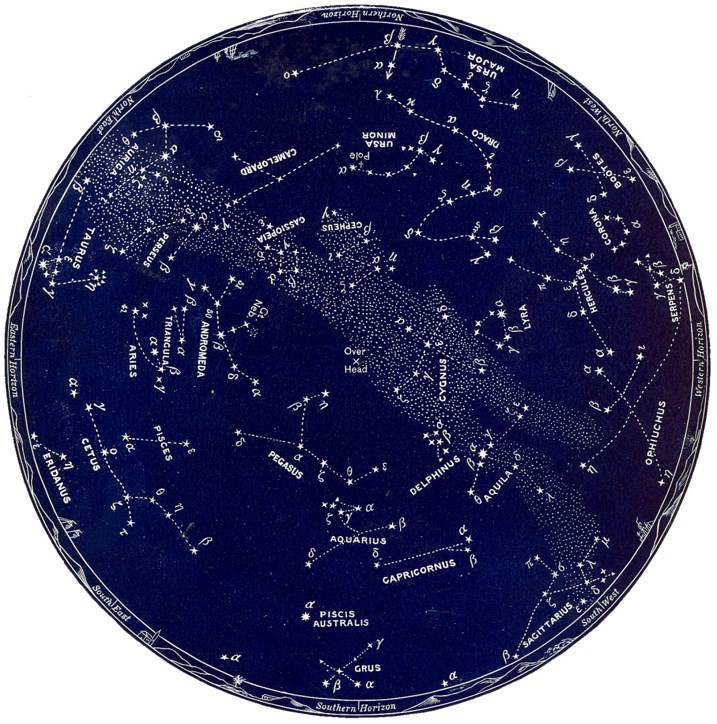

Stars of the first magnitude are eight-pointed; second magnitude, six-pointed; third magnitude, five-pointed; fourth magnitude (a few), four-pointed; fifth magnitude (very few), three-pointed. For star names refer to page 4.
MAP XI. NIGHT SKY.—OCTOBER AND NOVEMBER.
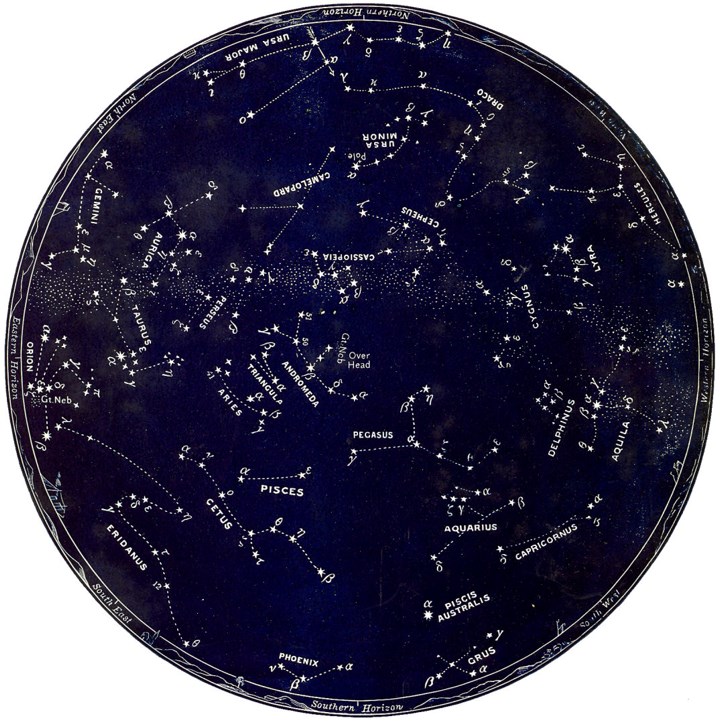

Stars of the first magnitude are eight-pointed; second magnitude, six-pointed; third magnitude, five-pointed; fourth magnitude (a few), four-pointed; fifth magnitude (very few), three-pointed. For star names refer to page 4.
NIGHT SKY.—OCTOBER AND NOVEMBER
The Dipper lies low, the Pointers a little east of north. They direct to the Pole Star. The Guardians of the Pole (β and γ of the Little Bear, Ursa Minor) lie in a direction from the pole star corresponding to that of the minute hand of a clock about 22 minutes before an hour. Between the Pointers and Pole Star lies the tip of the Dragon's Tail. Sweeping around the Little Bear (Ursa Minor) we find the stars of the Dragon (Draco) curving back by the star δ to the Dragon's Head, with the two bright eyes, γ and β. Above is the inconspicuous constellation Cepheus; and somewhat higher, the stars of Cassiopeia, α and β, marking the top rail of the Seated Lady's Chair.
Low down in the northwest Hercules is setting. Above is the Lyre, with the bright steel-blue Vega; and above that the stars of the Swan (Cygnus), which has sometimes been called the Northern Cross.
Nearly due west we find the Eagle (Aquila), ζ and ε marking its tail, θ the head. Above the Eagle is the pretty little constellation Delphinus, the Dolphin.
In the southwest, rather low, is the Sea Goat (Capricornus); above and to the south of him the Water Bearer (Aquarius), with his pitcher, marked by the stars, α, γ, and ζ. The head of the Winged Horse, Pegasus, now upside down (in fact, he is seldom otherwise), is just above this group. The "Square of Pegasus" will be noticed high up, due south. The star α of Andromeda, one of the corners of this square, used to be also called δ of Pegasus.
Much attention need not be directed to the Phœnix, low in the southern horizon. The River Eridanus is coming well into view; and the great Sea Monster (Cetus) now shows finely, his head at α and γ, his paddles at ζ and τ. The Fishes (Pisces) are above; the Ram (Aries) above them and eastward, lying toward the southeast; then the Triangle (Triangula, or the Triangles, according to modern maps), and the Chained Lady (Andromeda) too nearly overhead to be very pleasantly observed. The great nebula in which the new star recently appeared is near the point overhead.
The grand giant Orion is rising in the east; above him the Bull (Taurus) with the Pleiades. Low down in the northeast the Twins (Gemini) are rising; above is the Charioteer (Auriga), and above him the Rescuing Knight (Perseus), "of fair-haired Danae born." The Camelopard is hardly worth noticing, except as marking a barren region of the heavens.
NIGHT SKY.—NOVEMBER AND DECEMBER
The Great Bear (Ursa Major) is beginning to rise above the northeast (by north) horizon. The end of the Dipper's handle is hidden. A line from the Pole Star (toward which the Pointers direct the observer) to the Guardians of the pole (β and γ of the Little Bear, Ursa Minor), is now in the position of the minute hand of a clock 27 minutes before an hour. The stars of the Dragon wind round below the Little Bear toward the west, the head of the Dragon with the gleaming eyes ("oblique retorted that askant cast gleaming fire") being low down, a little north of northwest. Above is King Cepheus, and above him his queen, the Seated Lady (Cassiopeia); their daughter, the Chained Lady (Andromeda) being nearly overhead.
Low down in the northwest we see the Lyre (Lyra), with the bright Vega; and close by toward the west the Swan (Cygnus), or Northern Cross. The Eagle is setting in the west, and the Little Dolphin nears the western horizon.
Toward the southwest (by west) we see the Water Bearer (Aquarius), with his pitcher (β, γ, α), close by which is the head of the Winged Horse (Pegasus). In the south, low down, is the absurd Phœnix; above, the Sea Monster, or Whale (Cetus); above him, the Fishes (Pisces); above them, the Ram (Aries); while nearly overhead lies the Triangle, in reality the Triangles (Triangula).
The River (Eridanus) occupies the southeasterly sky. The Dove and Great Dog (Columba and Canis Major) are rising in the southeast. The glorious Orion has now come well into view, though not yet so upright as we could wish a knightly hunter to be. He treads on the Hare (Lepus), and faces the Bull (Taurus) above.
Due east we find the Crab (Cancer), and Little Dog (Canis Minor) low down; the Twins (Gemini) higher; above them the Charioteer (Auriga), with the bright Capella, and Perseus the Rescuer nearing the point overhead. In the mid-space between Perseus, Auriga, and the two Bears, we find the ridiculous constellation Camelopardus, or the Giraffe.


